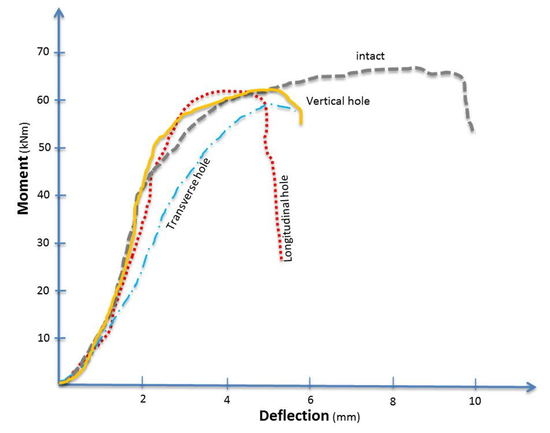Toughness of Railroad Concrete Crossties with Holes and Web Openings
Abstract
:1. Introduction
2. Experimental Evaluation
3. Results
4. Discussion
5. Conclusions
Acknowledgments
Author Contributions
Conflicts of Interest
References
- Remennikov, A.M.; Kaewunruen, S. A review on loading conditions for railway track structures due to wheel and rail vertical interactions. Struct. Eng. Health Monit. 2008, 15, 207–234. [Google Scholar] [CrossRef]
- Remennikov, A.M.; Murray, M.H.; Kaewunruen, S. Conversion of AS1085.14 for railway prestressed concrete sleeper to limit states design format. In Proceedings of the AusRAIL PLUS 2007 Conference & Exhibition, Sydney, Australia, 2–6 December 2007.
- Remennikov, A.M.; Murray, M.H.; Kaewunruen, S. Reliability based conversion of a structural design code for prestressed concrete sleepers. Proc. Inst. Mech. Eng. Part F J. Rail Rapid Transit. 2012, 226, 155–173. [Google Scholar] [CrossRef]
- Esveld, C. Modern Railway Track; MRT-Productions: Zaltbommel, The Netherland, 2001. [Google Scholar]
- British Standard, Railway applications. Track. Concrete Sleepers and Bearers. Prestressed Monoblock Sleepers; British Standards Institution: London, UK, 2009. [Google Scholar]
- Fryba, L. Dynamics of Railway Bridges; Thomas Telford Ltd.: London, UK, 1996. [Google Scholar]
- Gamage, E.; Kaewunruen, S.; Remennikov, A.M. Design of holes and web openings in railway prestressed concrete sleepers. In Proceedings of the Railway Engineering Conference, Edinburgh, UK, 28 June–July 2015.
- Kaewunruen, S.; Remennikov, A.M. Progressive failure of prestressed concrete sleepers under multiple high-intensity impact loads. Eng. Struct. 2007, 31, 2460–2473. [Google Scholar] [CrossRef]
- Kaewunruen, S.; Remennikov, A.M. Dynamic crack propagations of prestressed concrete sleepers in railway track systems subjected to severe impact loads. J. Struct. Eng. 2010, 136, 749–754. [Google Scholar] [CrossRef]
- Pfeil, H. Rail Seat Abrasion in Concrete Sleepered Track; Technical Report No. TR-016; NSW: RSA Technical Services, RailCorp: Sydney, Australia, 1997. [Google Scholar]
- Kaewunruen, S.; Remennikov, A.M. On the residual energy toughness of prestressed concrete sleepers in railway track structures subjected to repeated impact loads. Electron. J. Struct. Eng. 2013, 13, 41–61. [Google Scholar]
- Vu, M.; Kaewunruen, S.; Attard, M. Nonlinear 3D Finite Element Modeling for Structural Failure Analysis of Concrete Bearers at a Railway Urban Turnout Diamond; Elsevier: Amsterdam, The Netherlands, 2015. [Google Scholar]
- Kaewunruen, S.; Remennikov, A.M. Experimental simulation of the railway ballast by resilient materials and its verification by modal testing. Exp. Tech. 2008, 32, 29–35. [Google Scholar] [CrossRef]
- Kaewunruen, S. Monitoring structural deterioration of railway turnout systems via dynamic wheel/rail interaction. Case Stud. Nondestruct. Test. Eval. 2014, 1, 19–24. [Google Scholar] [CrossRef]
- Rahrovani, S. Structural Reliability and Identification with Stochastic Simulation: Application to Railway Mechanics. Ph.D. Thesis, Department of Applied Mechanics, Chalmers University of Technology, Gothenburg, Sweden, 2016. [Google Scholar]
- Kaewunruen, S.; Gamage, E.K.; Remennikov, A.M. Structural behaviours of railway prestressed concrete sleepers (crossties) with hole and web openings. Procedia Eng. 2016, 161, 1247–1253. [Google Scholar] [CrossRef]
- Kaewunruen, S.; Gamage, E.K.; Remennikov, A.M. Modelling railway prestressed concrete sleepers (crossties) with hole and web openings. Procedia Eng. 2016, 161, 1240–1246. [Google Scholar] [CrossRef]
- Kaewunruen, S.; Remennikov, A.M. Impact capacity of railway prestressed concrete sleepers. Eng. Fail. Anal. 2009, 16, 1520–1532. [Google Scholar] [CrossRef]
- Rezaie, F.; Bayat, M.A.; Farnam, S.M. Sensitivity analysis of pre-stressed concrete sleepers for longitudinal crack prorogation effective factors. Eng. Fail. Anal. 2016, 66, 385–397. [Google Scholar] [CrossRef]
- Chen, Z.; Andrawes, B.; Edwards, J.R. Finite element modelling and field validation of prestressed concrete sleepers and fastening systems. Struct. Infrastruct. Eng. 2016, 12, 631–646. [Google Scholar] [CrossRef]
- Kaewunruen, S.; Ishida, M. Field monitoring of rail squats using 3D ultrasonic mapping technique. J. Can. Inst. Nondestruct. Eval. 2014, 35, 5–11. [Google Scholar]
- Kaewunruen, S.; Remennikov, A.M. Rotational capacity of railway prestressed concrete sleeper under static hogging moment. In Proceedings of the 10th East Asia-Pacific Conference on Structural Engineering and Construction, Bangkok, Thailand, 3–5 August 2006.






| Crossties | Maximum Moment Capacity, kN·m | Failure Mode |
|---|---|---|
Intact (no holes or web opening) | 68 (100%) Bending failure |  |
With 42 mm diameter vertical hole | 61 (90%) Bending failure |  |
With 42 mm diameter transverse hole | 56 (82%) Mixed bending-shear failure |  |
With 42 mm diameter longitudinal hole
 | 61 (90%) Mixed bending-shear failure |  |
© 2017 by the authors; licensee MDPI, Basel, Switzerland. This article is an open access article distributed under the terms and conditions of the Creative Commons Attribution (CC-BY) license (http://creativecommons.org/licenses/by/4.0/).
Share and Cite
Gamage, E.K.; Kaewunruen, S.; Remennikov, A.M.; Ishida, T. Toughness of Railroad Concrete Crossties with Holes and Web Openings. Infrastructures 2017, 2, 3. https://doi.org/10.3390/infrastructures2010003
Gamage EK, Kaewunruen S, Remennikov AM, Ishida T. Toughness of Railroad Concrete Crossties with Holes and Web Openings. Infrastructures. 2017; 2(1):3. https://doi.org/10.3390/infrastructures2010003
Chicago/Turabian StyleGamage, Erosha K., Sakdirat Kaewunruen, Alex M. Remennikov, and Tetsuya Ishida. 2017. "Toughness of Railroad Concrete Crossties with Holes and Web Openings" Infrastructures 2, no. 1: 3. https://doi.org/10.3390/infrastructures2010003
APA StyleGamage, E. K., Kaewunruen, S., Remennikov, A. M., & Ishida, T. (2017). Toughness of Railroad Concrete Crossties with Holes and Web Openings. Infrastructures, 2(1), 3. https://doi.org/10.3390/infrastructures2010003








